It looks like you're using an Ad Blocker.
Please white-list or disable AboveTopSecret.com in your ad-blocking tool.
Thank you.
Some features of ATS will be disabled while you continue to use an ad-blocker.
share:
Strange Moons: Iapetus, A Walnut In Space
Iapetus.
Diameter: 1,468 km
Saturn's 3rd largest moon.
Surface temp: Varies from 90 - 130K ( -183 to -143 C )
Iapetus (sometimes referred to as Japetus), was discovered in 1671, by Giovanni Cassini. His discovery of this moon was very interesting because he could only observe it on the western side of Saturn, but never the eastern side of Saturn.
Turns out the reason was simple: Giovanni Cassini's telescope at that time was not good enough to see it on the eastern side of Saturn, because the moon's brightness dimmed by an order of 2 magnitudes compared to when it's on the western side of Saturn.
Cassini discovered this when he got a new and improved telescope in 1705. He surmised that Iapetus must have a very bright hemisphere on one side, and a very dark one on the other side.
This striking contrast stuck out to astronomers over time. Even science fiction writer Arthur C. Clarke mentions it in his book 2001: A Space Odyssey, however in his book he used the name Japetus (the book had the space ship Discovery go to Saturn instead of Jupiter as depicted in the Film).
Details of the moon could not be resolved by the most powerful telescopes here on Earth. However in August, 1981, Voyager 2 was able to fly by Iapetus at 600,000 miles, and gave us this image of it:
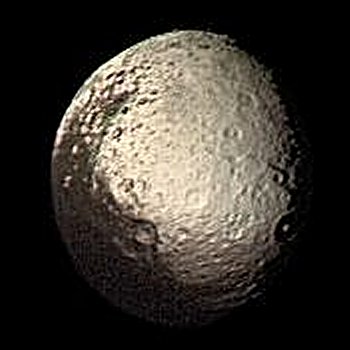
Voyager 2's image confirmed that the moon did indeed appear to have two highly contrasted hemispheres.
Iapetus is smaller than our moon, having a radius of only 42% of our moon:

When the space probe Cassini arrived at Saturn, it was able to start taking much higher resolution images of Iapetus. The contrast between the hemispheres is striking:

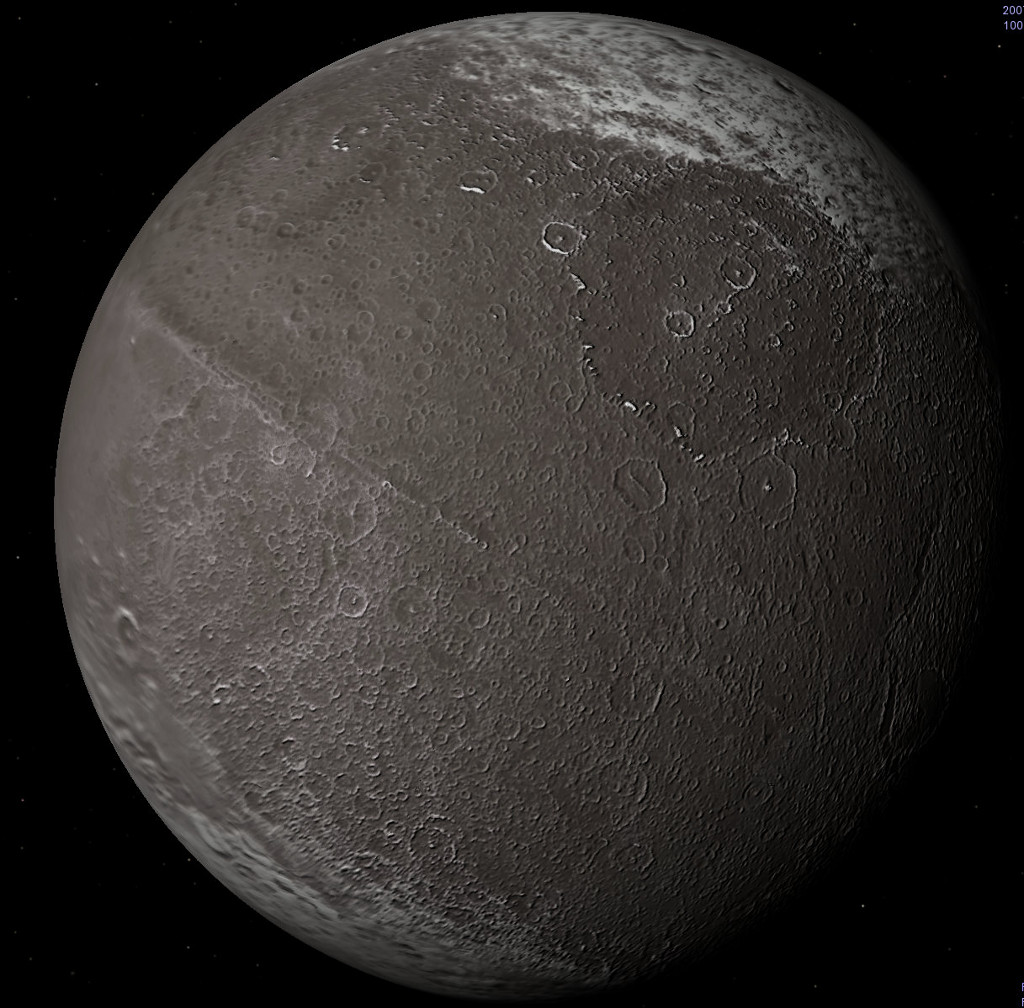
Close up image remind me of valleys with snow capped mountains:

So what is it that we are looking at here? Is it ice? If it is ice, why do we have two hemispheres with one being very much covered by that ice, while the other side is not?
Turns out with the help of Cassini's radar that the dark areas is actually pretty thin and believed to be "lag" (aka residue) from the sublimation of the water ice on the surface of Iapetus, that becomes darkened even further from exposure to sun light.
Iapetus has a slow rotation of 79 days. It has the warmest day time surface temps and coldest night time temps in the Saturn system (hence the dynamic surface temperature change from 90 Kelvin to 130 Kelvin).
It means that ice sublimates from the darker area and deposits to the lighter areas of the surface, especially over the poles of the moon.
As interesting as this contrast is, Cassini discovered another physical feature of Iapetus that gave it the nick name of Walnut Moon.
Cassini discovered a equatorial ridge that runs through the middle of the darker region of the moon in December, 2004:

The ridge is 1,300 km long, 20 km wide, and a average height of 13 km.
Some of the peaks reach as high as 20 km, making them some of the highest mountains in the solar system.
When looked at the right angle, the ridge helps give Iapetus a shape like a walnut:

Now for the strangeness of it: Scientist are not sure how it formed.
One problem that is difficult to explain is how the ridge follows the equator almost perfectly. There are about 4 hypothesis that are current, but none of them explains why the ridge is confined to the dark hemisphere either.
What ever the reason it is there, is sure is cool to look at:

Unfortunately, it is hard for Cassini to explore Iapetus extensively. Iapetus orbits Saturn from far out:

And it has a very inclined orbit around Saturn:

The cause of it's orbit being like this is not known. But it does make it difficult to get the Cassini probe back and forth from it. The last time Cassini visited Iapetus was in 2007 and there are no more planned visits. However, there might be a opportunity in 2015.
edit on 7-9-2013 by
eriktheawful because: (no reason given)
Now for the strangeness of it: Scientist are not sure how it formed.
One problem that is difficult to explain is how the ridge follows the equator almost perfectly. There are about 4 hypothesis that are current, but none of them explains why the ridge is confined to the dark hemisphere either.
One of those theories is that the matter blasted from the moon by the enormous impacts on its surface formed equatorial rings which slowly settled onto the equator of the moon, giving it that ridge like a walnut. I would be interested in hearing any others...
reply to post by eriktheawful
hi eriktheawful.
Very funny equator, in deed !! B-)
Almost every day I go see what happens there, with my bookmark:
CASSINI_SATURN ###*###
saturn.jpl.nasa.gov...
Blue skies.
hi eriktheawful.
Very funny equator, in deed !! B-)
Almost every day I go see what happens there, with my bookmark:
CASSINI_SATURN ###*###
saturn.jpl.nasa.gov...
Blue skies.
This stuff is discussed also in "Moon with a View" www.enterprisemission.com...
I remember there was also talk of strange hexagonal craters.
I remember there was also talk of strange hexagonal craters.
Very interesting moon! It's like Saturn has a zoo of exotic and peculiar specimens.
Cassini took some shots of Iapetus in June 2011 with its narrow-angle camera:
true-colour (Red/Green/Blue)

false-colour (IR/Green/UV)
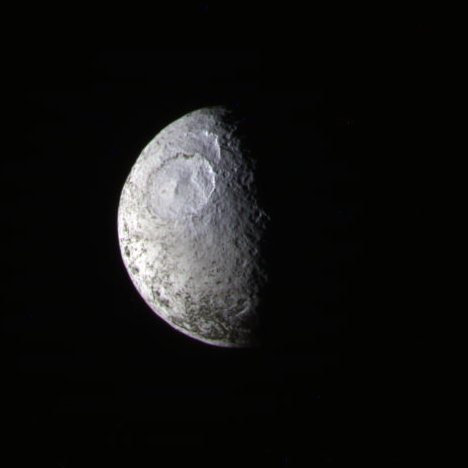
The last image enhances subtle colour variations of the terrain; some areas reflect more UV while others reflect more IR.
More on the dark side of Iapetus:
It occupies the leading hemisphere and sides of the moon, which to me suggests that the dark material has originally been swept up by the moon as it orbited Saturn. It contains organic compounds similar to the substances found in primitive meteorites or on the surfaces of comets; Earth-based observations have shown it to be carbonaceous, and it probably includes cyano-compounds such as frozen hydrogen cyanide polymers. Wiki
Cassini took some shots of Iapetus in June 2011 with its narrow-angle camera:
true-colour (Red/Green/Blue)

false-colour (IR/Green/UV)

The last image enhances subtle colour variations of the terrain; some areas reflect more UV while others reflect more IR.
More on the dark side of Iapetus:
It occupies the leading hemisphere and sides of the moon, which to me suggests that the dark material has originally been swept up by the moon as it orbited Saturn. It contains organic compounds similar to the substances found in primitive meteorites or on the surfaces of comets; Earth-based observations have shown it to be carbonaceous, and it probably includes cyano-compounds such as frozen hydrogen cyanide polymers. Wiki
Originally posted by intrptr
Now for the strangeness of it: Scientist are not sure how it formed.
One problem that is difficult to explain is how the ridge follows the equator almost perfectly. There are about 4 hypothesis that are current, but none of them explains why the ridge is confined to the dark hemisphere either.
One of those theories is that the matter blasted from the moon by the enormous impacts on its surface formed equatorial rings which slowly settled onto the equator of the moon, giving it that ridge like a walnut. I would be interested in hearing any others...
Here are the 4 popular theories as to how it formed:
#1
A team of scientists associated with the Cassini mission have argued that the ridge could be a remnant of the oblate shape of the young Iapetus, when it was rotating more rapidly than it does today. The height of the ridge suggests a maximum rotational period of 17 hours. If Iapetus cooled fast enough to preserve the ridge but remained plastic long enough for the tides raised by Saturn to have slowed the rotation to its current tidally locked 79 days, Iapetus must have been heated by the radioactive decay of aluminium-26. This isotope appears to have been abundant in the solar nebula from which Saturn formed, but has since all decayed. The quantities of aluminium-26 needed to heat Iapetus to the required temperature give a tentative date to its formation relative to the rest of the Solar System: Iapetus must have come together earlier than expected, only two million years after the asteroids started to form.
#2
The ridge could be icy material that welled up from beneath the surface and then solidified. If it had formed away from the position of the equator at the time, this hypothesis requires that the rotational axis would have been driven to its current position by the ridge
#3
Iapetus could have had a ring system during its formation due to its large Hill sphere, and that the equatorial ridge was then produced by collisional accretion of this ring. However, the ridge appears too solid to be the result of a collapsed ring. Also, recent images show tectonic faults running through the ridge, apparently inconsistent with the collapsed ring hypothesis.
#4
The ridge and the bulge are the result of ancient convective overturn. This hypothesis states that the bulge is in isostatic equilibrium typical for terrestrial mountains. It means that under the bulge there is material of low density (roots). The weight of the bulge is compensated by buoyancy forces acting on the roots[clarification needed]. The ridge is also built of less dense matter. Its position along the equator is probably a result of the Coriolis force acting on a liquid interior of Iapetus.
Source
I like all 4, but I think my favorite theory is the first one.
From the 2004 flyby, here's a mosaic of true-colour (RGB) images, created from raw images at saturn.jpl.nasa.gov...
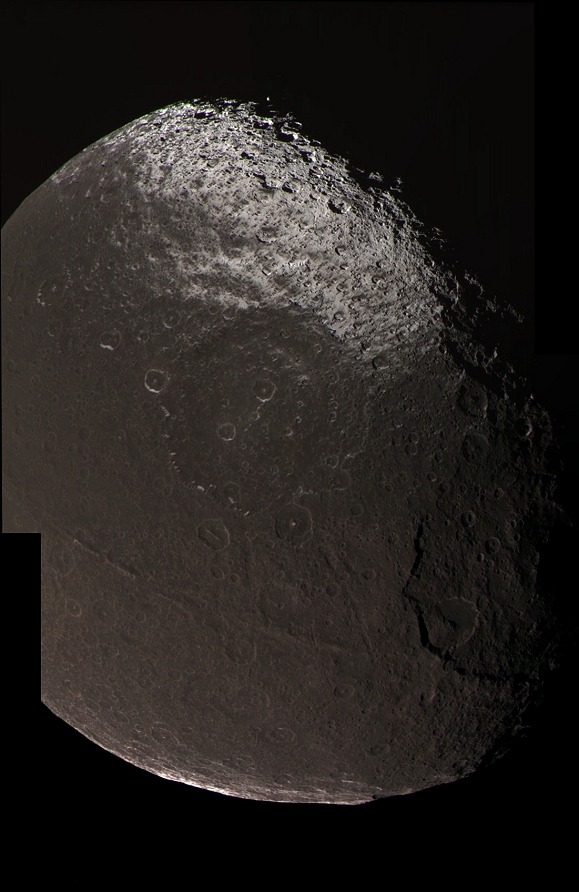
Full-size image: www.pictureshack.us...
Enigmatic place!
Also some great images and info here: solarsystem.nasa.gov...
Looks like there's a wealth of amazing images from the September 10, 2007 flyby to explore.

Full-size image: www.pictureshack.us...
Enigmatic place!
Also some great images and info here: solarsystem.nasa.gov...
Looks like there's a wealth of amazing images from the September 10, 2007 flyby to explore.
edit on 8-9-2013 by wildespace because: (no reason
given)
reply to post by wildespace
I think I will be doing Mimas next.
Something about that giant "Death Star" crater on it......and how many of Saturn's moons have it that is thought provoking to me.
I think I will be doing Mimas next.
Something about that giant "Death Star" crater on it......and how many of Saturn's moons have it that is thought provoking to me.
Could the ridge and orbit be explained by 2 moons coliding to make 1?
Originally posted by symptomoftheuniverse
Could the ridge and orbit be explained by 2 moons coliding to make 1?
While the ridge is suggestive of looking a bit like a seam, it does not encircle Iapetus.
Collisions on this scale, even at low speeds have a tremendous amount of energy. Taking two smaller moons (we'll say each half the size of Iapetus), each having half the mass of Iapetus and using the simple kenetic energy formula of KE= 1/2*(M*V^2), the energy released of such a collision would turn both smaller moons completely molten.
Gravity of such a large mass would reform them into a sphere, but would not leave a seam or bulge like that.
It's kind of hard to knock a planet or moon out of orbit through a collision with another object. Again, it's that energy that is involved. Gravity of objects is normally the main reason that planets and moons get their orbits changed, because unlike an impact, which is a very short and quick release of energy, gravity can have a very long and constant effect of the mass of a moon or planet.
If we look closer at Iapetus, we see that it has been smacked around by at least 4 large objects, as there are 4 very large craters that are around 500 km wide. While those are huge, the moon has one of the largest impact craters in the solar system, Mare Imbrium, measuring at 1,145 km wide.
It's possible that Iapetus was captured by Saturn at the beginning of the solar system's formation, and had a highly eccentric (oval shaped) orbit that over time, with influence of Saturn's gravity and other moons, forced it into the orbit is has today. However from what I understand, computer simulations of this do not support it, unless you start adding other large moons, which may have been flung away from Saturn. That's highly speculative, but not out of the question.
The snow-white side of Iapetus, with dark splatters. Love it!
RGB mosaic:
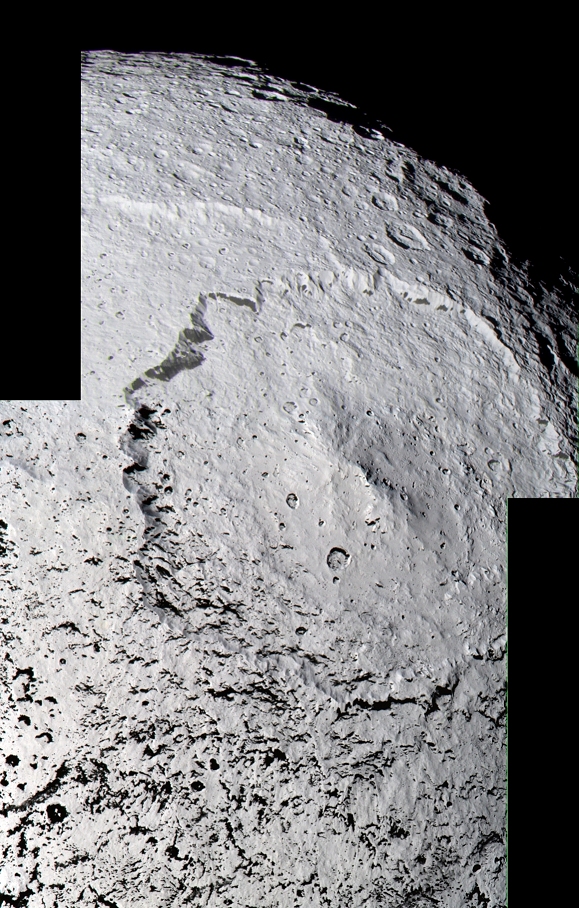
Full-size: www.pictureshack.us...
Global mosaic of the "white side" (in b&w):
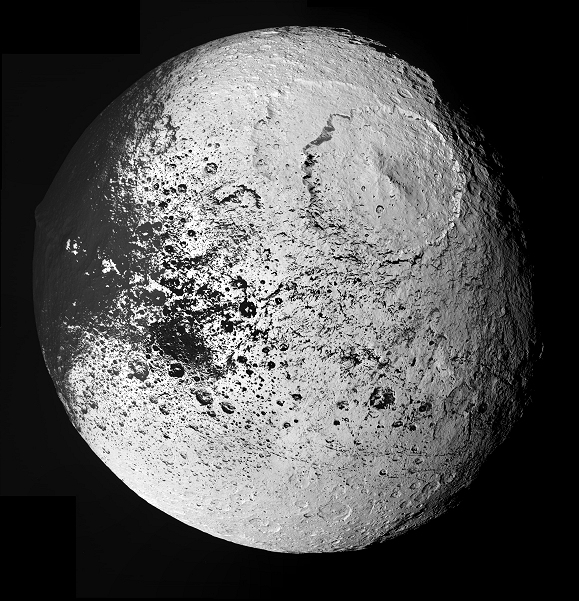
Full-size: www.pictureshack.us...
Interactive Photosynth: photosynth.net...
Those huge round craters are indeed peculiar, especially as they didn't seem to have left any crater rays or other signs of a violent impact. Just a nice round hole, like in golf.
RGB mosaic:

Full-size: www.pictureshack.us...
Global mosaic of the "white side" (in b&w):

Full-size: www.pictureshack.us...
Interactive Photosynth: photosynth.net...
Those huge round craters are indeed peculiar, especially as they didn't seem to have left any crater rays or other signs of a violent impact. Just a nice round hole, like in golf.
edit on 8-9-2013 by wildespace because: (no reason given)
reply to post by eriktheawful
Thanks for the rundown on the equatorial ridge, all of those are interesting. I did not know the ridge does not circumvent the globe.
theory #5:
(I'm making this up). The huge impacts altered the orbit away from Saturn where it had been accreting material directly from the rings of Saturn. Before the orbits change, it had a different spin rate as well so that material was only settling onto one side from Saturn.
theory #6
The impacts from twin objects (one on top of the other in rapid succession) set up opposing shockwaves that met around the other side of the planet, reflecting back and forth (like ripples in a pond go back and forth). The ridge formed where the rebounding shock waves met again and again...
Since the twin strikes (over lapped craters) are offset from each other, the ridge line only partially circumvents the globe. (I made that up too.)
Thanks for the rundown on the equatorial ridge, all of those are interesting. I did not know the ridge does not circumvent the globe.
theory #5:
(I'm making this up). The huge impacts altered the orbit away from Saturn where it had been accreting material directly from the rings of Saturn. Before the orbits change, it had a different spin rate as well so that material was only settling onto one side from Saturn.
theory #6
The impacts from twin objects (one on top of the other in rapid succession) set up opposing shockwaves that met around the other side of the planet, reflecting back and forth (like ripples in a pond go back and forth). The ridge formed where the rebounding shock waves met again and again...
Since the twin strikes (over lapped craters) are offset from each other, the ridge line only partially circumvents the globe. (I made that up too.)
Originally posted by intrptr
reply to post by eriktheawful
Thanks for the rundown on the equatorial ridge, all of those are interesting. I did not know the ridge does not circumvent the globe.
theory #5:
(I'm making this up). The huge impacts altered the orbit away from Saturn where it had been accreting material directly from the rings of Saturn. Before the orbits change, it had a different spin rate as well so that material was only settling onto one side from Saturn.
theory #6
The impacts from twin objects (one on top of the other in rapid succession) set up opposing shockwaves that met around the other side of the planet, reflecting back and forth (like ripples in a pond go back and forth). The ridge formed where the rebounding shock waves met again and again...
Since the twin strikes (over lapped craters) are offset from each other, the ridge line only partially circumvents the globe. (I made that up too.)
Nothing wrong with adding ideas to what the cause may have been.
It does look like a tsunami that was flash frozen.
Oh noes It's an alien spaceship orbiting planets via the slingshot affect!
Ok here is what really formed Iapetus,bare with me.
There are numerous different size blackholes darting around the galaxy at near light speeds. One such blackhole rushed through the center of Mars causing the huge volcano and the great canyon. The blackhole dragged a portion of mars core out towards saturn. Saturns gravity captured the core and saturns ice moons colided and covered half the moon in ice. The walnut shape is a result of interaction of gravitional fields of Mars,the blackhole and Saturn.....
So there you go,my supercomputer confirms this
There are numerous different size blackholes darting around the galaxy at near light speeds. One such blackhole rushed through the center of Mars causing the huge volcano and the great canyon. The blackhole dragged a portion of mars core out towards saturn. Saturns gravity captured the core and saturns ice moons colided and covered half the moon in ice. The walnut shape is a result of interaction of gravitional fields of Mars,the blackhole and Saturn.....
So there you go,my supercomputer confirms this
Originally posted by symptomoftheuniverse
Ok here is what really formed Iapetus,bare with me.
There are numerous different size blackholes darting around the galaxy at near light speeds. One such blackhole rushed through the center of Mars causing the huge volcano and the great canyon. The blackhole dragged a portion of mars core out towards saturn. Saturns gravity captured the core and saturns ice moons colided and covered half the moon in ice. The walnut shape is a result of interaction of gravitional fields of Mars,the blackhole and Saturn.....
So there you go,my supercomputer confirms this
Interesting theory, but there are some problems with it:
Iapetus mean density is 1.088. This means is made up mostly of ice water. Only 20% of Iapetus is actually rock, loosely spread through it.
Interesting idea though.
Originally posted by mcl1150
reply to post by eriktheawful
Fourth image looks like the Death Star from Star Wars, amazing!
Another of Saturn's moons -- Mimas -- looks even more like the death star from Star Wars:
Mimas:

Image Source
i forgot to mention it dragged a large proportion of the water on mars aswell. Where do you think saturns rings come from?
Originally posted by eriktheawful
Originally posted by symptomoftheuniverse
Ok here is what really formed Iapetus,bare with me.
There are numerous different size blackholes darting around the galaxy at near light speeds. One such blackhole rushed through the center of Mars causing the huge volcano and the great canyon. The blackhole dragged a portion of mars core out towards saturn. Saturns gravity captured the core and saturns ice moons colided and covered half the moon in ice. The walnut shape is a result of interaction of gravitional fields of Mars,the blackhole and Saturn.....
So there you go,my supercomputer confirms this
Interesting theory, but there are some problems with it:
Iapetus mean density is 1.088. This means is made up mostly of ice water. Only 20% of Iapetus is actually rock, loosely spread through it.
Interesting idea though.
new topics
-
Swarms of tiny 'ant-like' robots lift heavy objects and navigate obstacles
Science & Technology: 28 minutes ago -
NYPD Chief Jeffrey Maddrey Resigns - Forced Officers to Give Sex for Overtime Pay and Favors.
Posse Comitatus: 1 hours ago -
The Carpet Coating that Attacked the Environment
Medical Issues & Conspiracies: 5 hours ago -
Microplastics in your drinks
Medical Issues & Conspiracies: 7 hours ago
top topics
-
The Carpet Coating that Attacked the Environment
Medical Issues & Conspiracies: 5 hours ago, 11 flags -
China Working on 'Drone Mothership' Plane
Military Projects: 12 hours ago, 10 flags -
Microplastics in your drinks
Medical Issues & Conspiracies: 7 hours ago, 5 flags -
Happy Rush Day 2024 - 2112
Music: 12 hours ago, 4 flags -
12-21-24 Usyk-Fury II
World Sports: 15 hours ago, 1 flags -
NYPD Chief Jeffrey Maddrey Resigns - Forced Officers to Give Sex for Overtime Pay and Favors.
Posse Comitatus: 1 hours ago, 1 flags -
Swarms of tiny 'ant-like' robots lift heavy objects and navigate obstacles
Science & Technology: 28 minutes ago, 0 flags
active topics
-
Donald Trump Should Offer AMNESTY to the BIDEN FAMILY For Indicting Blackmailers-Controllers.
US Political Madness • 78 • : WeMustCare -
Drones everywhere in New Jersey ---and Elsewhere Master Thread
Aliens and UFOs • 220 • : imitator -
JOSEPH BIDEN Says Democrat Coup Leaders Forced Him to Resign the Presidency - Eff 1.20.2025.
2024 Elections • 55 • : WeMustCare -
Democrat Leader Hakeem Jeffries Promotes HATE After 2nd Attempt to Murder Trump in 2024.
US Political Madness • 41 • : WeMustCare -
Flying saucer spotted during the Trump assassination attempt
Aliens and UFOs • 66 • : WeMustCare -
Swarms of tiny 'ant-like' robots lift heavy objects and navigate obstacles
Science & Technology • 0 • : 727Sky -
Microplastics in your drinks
Medical Issues & Conspiracies • 13 • : WeMustCare -
NYPD Chief Jeffrey Maddrey Resigns - Forced Officers to Give Sex for Overtime Pay and Favors.
Posse Comitatus • 4 • : WeMustCare -
'Mass Casualty event' - Attack at Christmas market in Germany
Mainstream News • 136 • : 777Vader -
My personal experiences and understanding of orbs
Aliens and UFOs • 25 • : Compendium
